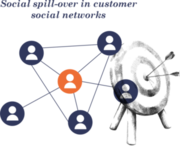“Deciding which movie to see [in a twenty-screen multiplex] may be so hard that you end up staying home and watching TV,” writes US psychologist Barry Schwartz in a companion essay to his highly influential book on choice overload, The Paradox of Choice. That's because, he writes, “choosing is work: it takes time, attention and effort.” And our resources – in time, abilities, etc. – are limited, meaning that the rationality of our decision-making is limited too, an effect that economists have named “bounded rationality”. As a consequence, individuals facing a complex choice (dozens of movies and show times, or an entire supermarket aisle of chocolate bars) will sometimes give up on sifting through all the product information and choose the best option given the information they have collected up to a point. Accounting for this consumer decision-making process usually helps improve the prediction of individual purchase decision. However, the major challenge is that this decision process is hard to observe.
Recognizing the limitations of existing statistical models
Since the early 1980s, business has relied heavily on choice-based questionnaires to collect consumer preference data, using statistical models to recover consumer preferences. Without observations of the decision process, existing statistical models usually assume that consumers collect all choice-relevant information before making a decision. Since the way in which consumers search for choice-relevant information reveals their preferences, a statistical model with wrong assumptions about these information acquisition processes could bias marketing managers' estimations of consumer preferences and make prediction of purchases less accurate. How then can market research take these limitations into account? A team of researchers has come up with a statistical model that does just that, and should help marketing practitioners improve the accuracy of measuring consumer preference and therefore the prediction of consumer choices with shorter questionnaires.
Modeling the information acquisition process
The researchers observed that people don't process all relevant information when making choices, such as, for example, when choosing a laptop. The area of the questionnaire on their online platform that consumers attend to reveals their preferences: “Maybe a teenage girl will only attend to the color and size of the screen whereas a teenage boy will also care about the speed of the processor to play games,” explains Cathy Yang, one of the researchers. That's why she and her co-authors developed a model to capture information acquisition (finding out about the relevant information for purchasing a laptop) as a result of forward-looking utility maximization, in which the utility a consumer derives comes not only from the chosen product but also from the information acquisition process itself (is it worth reading about and assessing x specifications).
Not all consumers will attend to the same features.
Eye-tracking as a measure of attention and information acquisition
Recent marketing studies have relied on eye-tracking data as a measure of attention allocation for many purposes, from branding to search effectiveness and brand display on supermarket shelves, and the authors believe it will become more and more widespread, if not systematic, as a way of fine-tuning the understanding of how consumers make purchase decisions. As Cathy Yang recalls, in the late 1980s and early 1990s, marketers relied on mouse-tracking to understand the information acquisition process: the subject's information acquisition processed was captured by tracking the mouse clicks necessary to open boxes which contained relevant information presented on a computer screen. “But it was an intrusive, non-natural process, whereas an eye-tracker looks just like a regular screen,” she adds. In this study, the authors leverage eye-tracking data as a direct measure of attention and information acquisition. Eye-tracking data is one way of inferring the decision process and signaling which features of a product are more important to different users. For instance, when presented information about the same laptop, one consumer might devote 80% of his or her attention to the screen attributes, 15% to hard disk capacity and only 5% to the rest. “Not all consumers will attend to the same features,” says Cathy Yang. Managers can gain insight into consumers’ heterogeneous preferences from the eye-tracking data.
It is technical to collect eye-tracking data, but, today, commercial solutions are available for collection of eye-tracking data in an online environment using webcams. “We expect such solutions to be increasingly common as large companies such as Facebook acquire such capabilities […] and with the development of open-source solutions,” write the authors.










